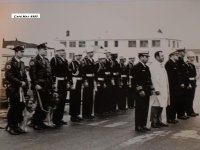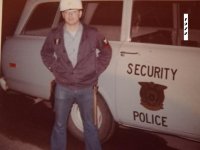I was looking at the Sarco ad in Firearms News and they have several reproduction lanyards for sale.
You are using an out of date browser. It may not display this or other websites correctly.
You should upgrade or use an alternative browser.
You should upgrade or use an alternative browser.
Lanyard Loop
- Thread starter Kinman
- Start date
James K
Member
I was always under the impression the lanyard loop goes under the epaulette. I have a 1942 P-38 and bought an Austrian field shirt with the button-down epaulettes. Makes much more sense to me than doing it the Tuco way.
For a good portion of the time I spent USAREUR, lanyards were required by unit policy. I attached mine to my M7 shoulder holster. As a tank commander you learned early on to never move through woods at night without the .50 cal at max elevation. With lanyards on the CEOI, compass, and a pair of binoculars you might easily find yourself with a hanging to attend. This became doubly important if moving over any ground that may have had TOW missiles fired across it.
James K
Member
I was just watching a TV interview with a MO Highway Patrol Sergeant regarding the recent tornado damage there and he was sporting both a leather braided lanyard and another 1" wide leather strap under his left epaulette. Looked good.
m75rlg
US Veteran
Here is a photo of the dress lanyard used with 1911s in the Coast Guard in 1972. (Note that the second PO from the left has failed to snap his lanyard to the 1911 and has it returning the the lanyard looped over his right shoulder. That is the way we wore the lanyard when in full dress with our "security police accesories" but not armed.)
i do not recall ever using a lanyard when we were working. Heck, most of the time we didn't even bother to carry the 1911, just our sticks. (see second photo.)
i do not recall ever using a lanyard when we were working. Heck, most of the time we didn't even bother to carry the 1911, just our sticks. (see second photo.)
Attachments
Last edited:
lynnbarrow
Member
- Joined
- Apr 2, 2015
- Messages
- 9
- Reaction score
- 24
Different lanyard use
I had a S&W Model 10 several years back that was engraved on the side San Quenten. It had a screw eye threaded into one of the stocks and had obviously been hung on the back of a door. When the door was opened the revolver swung back and forth causing the stock next to the door to be worn almost smooth.
So wear from use of a lanyard loop can be a problem.
I had a S&W Model 10 several years back that was engraved on the side San Quenten. It had a screw eye threaded into one of the stocks and had obviously been hung on the back of a door. When the door was opened the revolver swung back and forth causing the stock next to the door to be worn almost smooth.
So wear from use of a lanyard loop can be a problem.
RM Vivas
US Veteran
Original source:
Mayor speaking at reviewing stand (In distance). In foreground (backs to camera) enlisted army members stand at ease. Police and army contingent in stand. - WOD: Mayor William O'Dwyer
Identifier:
wod_266
Title:
Mayor speaking at reviewing stand (In distance). In foreground (backs to camera) enlisted army members stand at ease. Police and army contingent in stand.
Credit:
Archer, Alexander
Subject:
Special Events
Subject:
O'Dwyer, William, 1890-1964
Date:
September 16, 1949
Type:
Gelatin-Silver Print
Format:
8 x 10 inches
Place:
City Hall Steps
Notes:
49 European journalists tour US.
Prints:
1

This 1949 photo of enlisted military police at a ceremony at City Hall shows lanyards on one shoulder under epaulets.
Best,
RM Vivas
Mayor speaking at reviewing stand (In distance). In foreground (backs to camera) enlisted army members stand at ease. Police and army contingent in stand. - WOD: Mayor William O'Dwyer
Identifier:
wod_266
Title:
Mayor speaking at reviewing stand (In distance). In foreground (backs to camera) enlisted army members stand at ease. Police and army contingent in stand.
Credit:
Archer, Alexander
Subject:
Special Events
Subject:
O'Dwyer, William, 1890-1964
Date:
September 16, 1949
Type:
Gelatin-Silver Print
Format:
8 x 10 inches
Place:
City Hall Steps
Notes:
49 European journalists tour US.
Prints:
1

This 1949 photo of enlisted military police at a ceremony at City Hall shows lanyards on one shoulder under epaulets.
Best,
RM Vivas
THE PILGRIM
Member
O
During War Two my FIL was in Casablanca and needed to return to Marrakesh.
He got a hop with a Brit in a Mosquito.
The RAF Pilot was carrying a Webley with a lanyard around his neck.
He took the Webley out of his holster and laid it on the side console.
My FIL was carrying his issued 1917.
During War Two my FIL was in Casablanca and needed to return to Marrakesh.
He got a hop with a Brit in a Mosquito.
The RAF Pilot was carrying a Webley with a lanyard around his neck.
He took the Webley out of his holster and laid it on the side console.
My FIL was carrying his issued 1917.
I've seen a photograph of Lejeune's pistol rig set-up and he had a lanyard not just for the pistol but also the magazines. Remember, the early magazines did have lanyard loops as well!
Best,
RM Vivas
Considering how the Corps was always short of gear, he probably couldn't have found any replacement mags if he lost the ones issued to him!
Years ago, I read about one of the early battles on Guadalcanal, where after the fighting was over, a senior sergeant, who had served in the Marines since the lean years between the World Wars, asked the BAR gunner what happened to his empty magazines. When told that they were left on the battlefield, the sergeant made the young jarhead go back out and retrieve them.
Last edited:
Similar threads
- Replies
- 29
- Views
- 3K
- Replies
- 5
- Views
- 485
- Replies
- 14
- Views
- 2K


